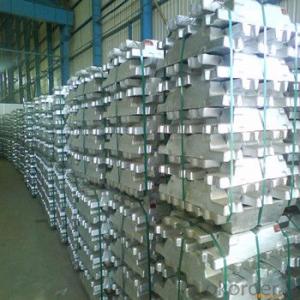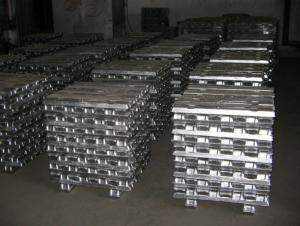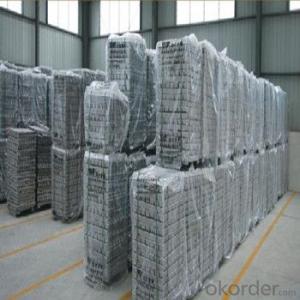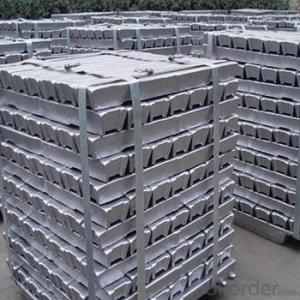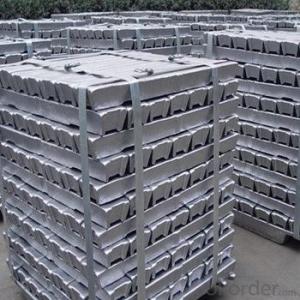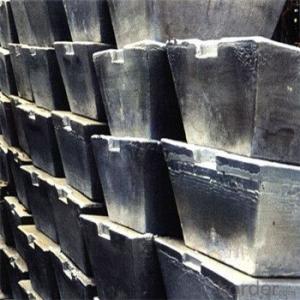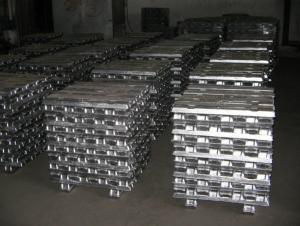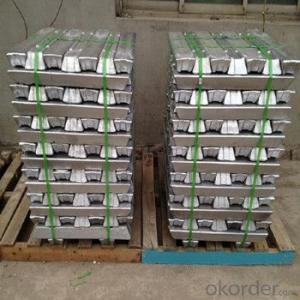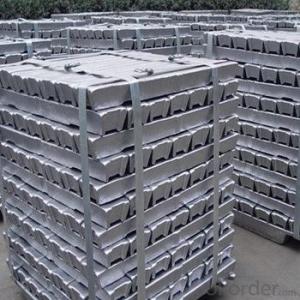Aluminum Pig/Ingot With Best Price From China
- Loading Port:
- China main port
- Payment Terms:
- TT OR LC
- Min Order Qty:
- 1000 m.t.
- Supply Capability:
- 100000 m.t./month
OKorder Service Pledge
OKorder Financial Service
You Might Also Like
Pure Aluminum Pig/Ingot Used for Industry
1.Structure of Aluminum Pig/Ingot
A material that has been cast into a shape in order to be transported and processed easier than in an unprocessed form. An ingot is typically rectangular in shape, which allows it to be stacked. Ingots are most commonly associated with metals, with ingots of gold held in the vaults of banks and brokerages being popular images.
Aluminum Ingot is with the AL as the main chemical composition.Aluminum Ingot is used for industry,such as automobile,pinning and weaving,electron broadly and so on. Aluminum Ingot has the following advantages: easy control and operation, fast melting.
2.Main Features of the Aluminum Pig/Ingot
•High Purity
•Easy control and operation
•High strength
•Fast melting
•Competitive price
•Best Service
3.Aluminum Pig/Ingot Images
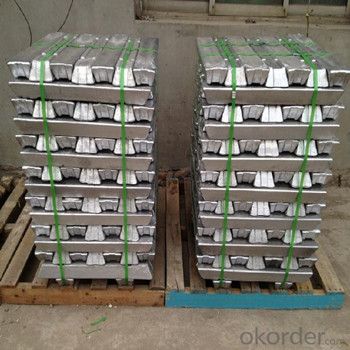

4.Aluminum Pig/Ingot Specification
Grade | Chemical Composition % | |||||||||
Al≥ | impurities ≤ | |||||||||
Si | Fe | Cu | Ga | Mg | Zn | Mn | others | Sum | ||
Al99.9 | 99.90 | 0.50 | 0.07 | 0.005 | 0.02 | 0.01 | 0.025 | - | 0.010 | 0.10 |
Al99.85 | 99.85 | 0.80 | 0.12 | 0.005 | 0.03 | 0.02 | 0.030 | - | 0.015 | 0.15 |
Al99.7 | 99.70 | 0.10 | 0.20 | 0.010 | 0.03 | 0.02 | 0.030 | - | 0.030 | 0.30 |
Al99.6 | 99.60 | 0.16 | 0.25 | 0.010 | 0.03 | 0.03 | 0.030 | - | 0.030 | 0.40 |
Al99.5 | 99.50 | 0.22 | 0.30 | 0.020 | 0.03 | 0.05 | 0.050 | - | 0.030 | 0.50 |
Al99.00 | 99.00 | 0.42 | 0.50 | 0.020 | 0.03 | 0.05 | 0.050 | - | 0.050 | 1.00 |
5.FAQ of Aluminum Pig/Ingot
We have organized several common questions for our clients,may help you sincerely:
①How about your company?
A professional manufacturers of the alumiun pig.Devoted in this industry for many years,so got much experice.The quality and service have also accepted by customer.Can meet customers' requiements to provide different grade and purity alumiun pig.
②How to guarantee the quality of the products?
We have established the international advanced quality management system,every link from raw material to final product we have strict quality test;We resolutely put an end to unqualified products flowing into the market. At the same time, we will provide necessary follow-up service assurance.
③How long can we receive the prod rking days, We will arrange the factory delivery as soon as possible. The pecific time of receiving is related to the state and position of customers.Commonly 7 to 10 working days can be served.
- Q:What is the tensile strength of aluminum ingots?
- The specific alloy and manufacturing process employed can cause variations in the tensile strength of aluminum ingots. On average, the tensile strength of these ingots falls within the range of 70 to 700 megapascals (MPa). It is crucial to consider that factors like the purity level, presence of impurities, and the heat treatment process can influence the tensile strength. Moreover, different aluminum alloys exhibit distinct tensile strengths, necessitating the specification of the alloy in order to determine the tensile strength of aluminum ingots accurately.
- Q:Can aluminum ingots be used in 3D printing?
- Indeed, aluminum ingots have the ability to be utilized in the realm of 3D printing. The reason behind this lies in the fact that aluminum possesses attributes such as being lightweight, possessing high strength, and exhibiting exceptional thermal conductivity. Nevertheless, instead of employing aluminum ingots directly, a technique known as powder bed fusion comes into play. More specifically, one can utilize selective laser melting (SLM) or electron beam melting (EBM) within this process. The modus operandi is as follows: fine aluminum powder is evenly distributed in thin layers, subsequently being selectively melted through the application of a laser or electron beam, layer by layer, in order to achieve the desired 3D object. This method enables the production of intricate geometries and exact parts, all while maintaining an elevated level of strength and precision.
- Q:What are the different casting methods used for aluminum ingots?
- The different casting methods used for aluminum ingots include permanent mold casting, die casting, and continuous casting.
- Q:Aluminum sold alone, high benefit ah, why do aluminum ingot?
- No, aluminium powder is made of aluminium ingots
- Q:How are aluminum ingots used in the production of electrical enclosures?
- The unique characteristics and properties of aluminum ingots are crucial in producing electrical enclosures. These ingots are melted and cast into specific shapes and sizes to create the main components of the enclosures. To begin with, aluminum is highly desirable for electrical enclosures because of its excellent conductivity. It allows electrical currents to flow efficiently through the enclosure, ensuring the proper functioning of the electronic devices inside. This conductivity helps prevent any interference or disruption in the electrical circuit. Moreover, aluminum is renowned for its lightweight and corrosion-resistant properties. This makes it an ideal choice for electrical enclosures, as they need to be durable and resistant to environmental factors like moisture, dust, and chemicals. Aluminum's corrosion resistance ensures the enclosure remains intact and functional for a longer period, even in harsh conditions. Furthermore, aluminum ingots can be easily machined and fabricated into various shapes, enabling manufacturers to design enclosures that meet specific requirements. The ingots are melted and poured into molds, creating the desired shape and allowing customization and flexibility in the production process. This versatility is particularly important in the electrical industry, where enclosures must accommodate different types of equipment and wiring configurations. Additionally, aluminum ingots are often preferred for their thermal conductivity. Electrical enclosures generate heat due to the operation of enclosed devices. Aluminum efficiently dissipates this heat, preventing overheating and ensuring the safety and longevity of electronic components. In summary, aluminum ingots are extensively used in producing electrical enclosures because of their conductivity, lightweight, corrosion resistance, ease of fabrication, and thermal conductivity. These qualities make aluminum an excellent material choice for creating enclosures that protect and enhance the performance of electrical equipment.
- Q:How long can aluminum ingots be stored?
- Aluminum ingots can be stored for an indefinite period of time if they are properly stored and protected from certain environmental conditions. It is recommended to store aluminum ingots in a dry and well-ventilated area to prevent any moisture buildup, which could lead to corrosion. Additionally, it is important to protect the ingots from exposure to extreme temperatures or direct sunlight, as it can cause the material to expand or warp. By following these storage guidelines, aluminum ingots can be stored for an extended period without any significant degradation in quality.
- Q:Can aluminum ingots be used in medical applications?
- Medical applications can utilize aluminum ingots effectively. Aluminum, known for its versatility and advantages in the medical field, offers lightweight properties, corrosion resistance, and excellent thermal conductivity. These qualities make it an optimal choice for a range of medical devices and equipment. Manufacturing medical devices like prosthetics, orthopedic implants, and surgical instruments can utilize aluminum ingots. These ingots can be precisely shaped and sized to meet specific requirements in medical applications. Furthermore, aluminum is commonly employed in the production of medical equipment such as MRI machines, X-ray machines, and dental tools. Moreover, aluminum ingots find use in the production of medical packaging materials. Aluminum foils, with their ability to act as a barrier against moisture, light, and oxygen, are ideal for packaging pharmaceutical products. This ensures the integrity and longevity of medications. It is crucial to emphasize that the utilization of aluminum in medical applications must adhere to strict regulations and guidelines to guarantee patient safety. Manufacturers must rigorously comply with quality control measures and conduct thorough testing to ensure the biocompatibility and safety of the final product. To conclude, aluminum ingots possess favorable properties that make them suitable for various medical applications. Nonetheless, it is essential to prioritize compliance with applicable regulations and standards to ensure the safety and effectiveness of the final medical product.
- Q:What are the common uses of aluminum ingots?
- Aluminum ingots have a wide range of common uses due to their unique properties. One of the most common uses is in the manufacturing of various products in the automotive industry. Aluminum ingots are used to make engine components, such as cylinder heads and engine blocks, as well as body panels and wheels. The lightweight nature of aluminum makes it ideal for improving fuel efficiency and reducing vehicle weight. Another prominent use of aluminum ingots is in the construction industry. Aluminum is used to fabricate window frames, door frames, roofing materials, and structural elements. It is highly corrosion-resistant, which makes it suitable for outdoor applications. Additionally, its lightweight nature allows for easy installation and transportation. The packaging industry also heavily relies on aluminum ingots. Aluminum is used to make cans for beverages and food items due to its excellent barrier properties, which protect the contents from light, moisture, and air. Moreover, aluminum cans are easily recyclable, making them a sustainable choice. Aluminum ingots are also widely used in the electrical industry. They are utilized in the production of power transmission lines, electrical wiring, and conductors. Aluminum's high electrical conductivity and low weight make it an ideal material for conducting electricity efficiently and cost-effectively. Lastly, aluminum ingots find applications in the aerospace industry. The lightweight yet strong characteristics of aluminum make it an excellent choice for manufacturing aircraft components, including wings, fuselages, and structural parts. The weight reduction achieved with aluminum significantly improves fuel efficiency and overall performance. Overall, the common uses of aluminum ingots span across various industries, including automotive, construction, packaging, electrical, and aerospace. Its versatility, strength, and lightweight nature make it an essential material in modern manufacturing processes.
- Q:What are the different surface treatments for aluminum ingots?
- There are several different surface treatments available for aluminum ingots, depending on the desired outcome and application. Some commonly used surface treatments for aluminum ingots include: 1. Anodizing: This is a process that creates a protective oxide layer on the surface of the aluminum ingot. Anodizing can provide corrosion resistance, increase durability, and improve the aesthetic appearance of the aluminum. 2. Powder coating: Powder coating involves applying a dry powder to the surface of the aluminum ingot, which is then cured under heat to form a protective and decorative coating. Powder coating offers excellent resistance to corrosion, fading, and scratching, while also providing a wide range of color options. 3. Polishing: Polishing is a mechanical process that involves buffing the surface of the aluminum ingot to achieve a smooth and glossy finish. This treatment enhances the appearance of the aluminum and can also improve its resistance to corrosion. 4. Brushing: Brushing is a surface treatment that involves using abrasive brushes to create a textured or brushed finish on the aluminum ingot. This treatment is often used to achieve a decorative or industrial look, while also providing a certain level of corrosion resistance. 5. Chemical etching: Chemical etching is a process that involves using chemicals to selectively remove material from the surface of the aluminum ingot. This treatment can create intricate patterns, logos, or text on the surface of the aluminum, making it suitable for branding or decorative purposes. 6. Clear coat: Applying a clear coat to the surface of the aluminum ingot can provide an additional layer of protection against corrosion, while also preserving the natural appearance of the metal. Clear coats often contain protective additives that enhance the longevity of the aluminum. It is important to consider the specific requirements of the application and consult with professionals in the field to determine the most suitable surface treatment for aluminum ingots.
- Q:What are the different surface finishes available for aluminum ingots?
- The different surface finishes available for aluminum ingots include mill finish, brushed finish, anodized finish, powder-coated finish, and polished finish.
1. Manufacturer Overview |
|
|---|---|
| Location | |
| Year Established | |
| Annual Output Value | |
| Main Markets | |
| Company Certifications | |
2. Manufacturer Certificates |
|
|---|---|
| a) Certification Name | |
| Range | |
| Reference | |
| Validity Period | |
3. Manufacturer Capability |
|
|---|---|
| a)Trade Capacity | |
| Nearest Port | |
| Export Percentage | |
| No.of Employees in Trade Department | |
| Language Spoken: | |
| b)Factory Information | |
| Factory Size: | |
| No. of Production Lines | |
| Contract Manufacturing | |
| Product Price Range | |
Send your message to us
Aluminum Pig/Ingot With Best Price From China
- Loading Port:
- China main port
- Payment Terms:
- TT OR LC
- Min Order Qty:
- 1000 m.t.
- Supply Capability:
- 100000 m.t./month
OKorder Service Pledge
OKorder Financial Service
Similar products
New products
Hot products
Hot Searches
